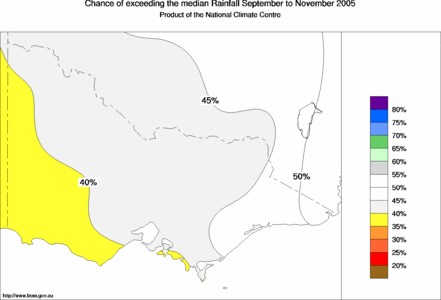| Vic Seasonal Rainfall Outlook: probabilities for Spring 2005, issued 16th August 2005 | |
Drier spring more likely in western VictoriaThere is an increased chance of a drier than average spring (September to November) over much of western Victoria, the Bureau of Meteorology announced today. This includes some of the areas that have been suffering severe short-term rainfall deficiencies since the start of autumn, and longer-term deficiencies extending back more than a year. See the Drought Statement for more information. The pattern of seasonal rainfall odds is a result of continuing above average temperatures in both the Indian and tropical Pacific Oceans. 
For the September to November period, the chances of above median rainfall are between 35 and 40% west of a line from Loxton (SA) to Lorne, southwest of Geelong (see map). So in years with ocean patterns like the current, about four springs out of ten are expected to be wetter than median over this part of the State, with about six out of ten being drier. However, history shows only a weakly consistent influence from ocean temperatures on spring rainfall in southwest Victoria, so this outlook should be applied with caution in that area. Across remaining parts of Victoria, the chances of reaching the seasonal median are between 40 and 50%. Outlook confidence is related to the influence of Pacific and Indian Ocean temperatures on seasonal rainfall. During spring, history shows this influence to be moderately consistent across most of Victoria, with the exception of the southwest of the State (see background information). After reaching a positive value in June (+3), the Southern Oscillation Index (SOI) was steady in July with a value of +1. The approximate SOI for the 30 days ending 13th August was −6. With the positive values of the SOI, recent cooling of the tropical Pacific and continued neutral cloud and wind patterns across the Pacific, the chances of an El Niño developing in 2005 are slim. For routine updates and comprehensive discussion on the latest data relating to El Niño, together with details on what the phenomenon is and how it has affected Australia in the past, see the ENSO Wrap-Up. | |
Click on the map above for a larger version of the map. Use the reload/refresh button to ensure the latest forecast map is displayed. | |
| More information on this outlook is available from 9.00am to 5.00pm (EST) Monday to Friday by contacting the Climate and Consultancy section in the Bureau's Victorian Regional Office: (03) 9669 4949. | |
THE NEXT ISSUE OF THE SEASONAL OUTLOOK IS EXPECTED BY 15th SEPTEMBER 2005 Corresponding temperature outlook | |
Background Information
|









